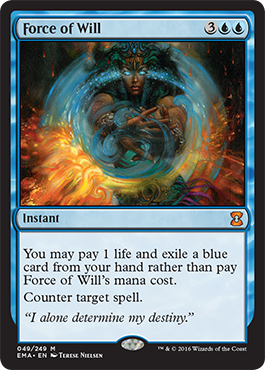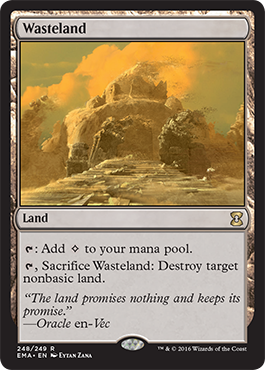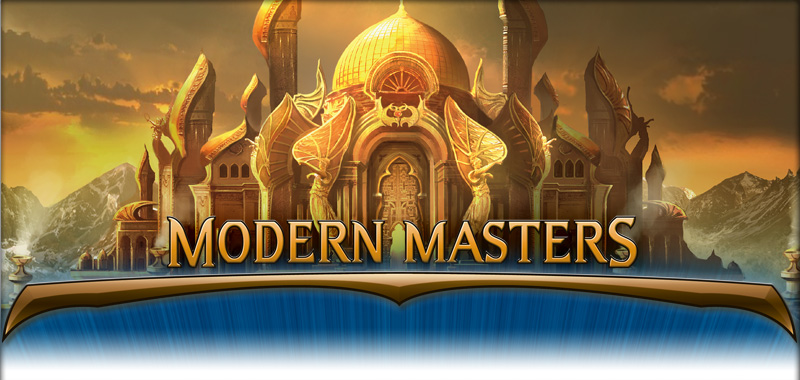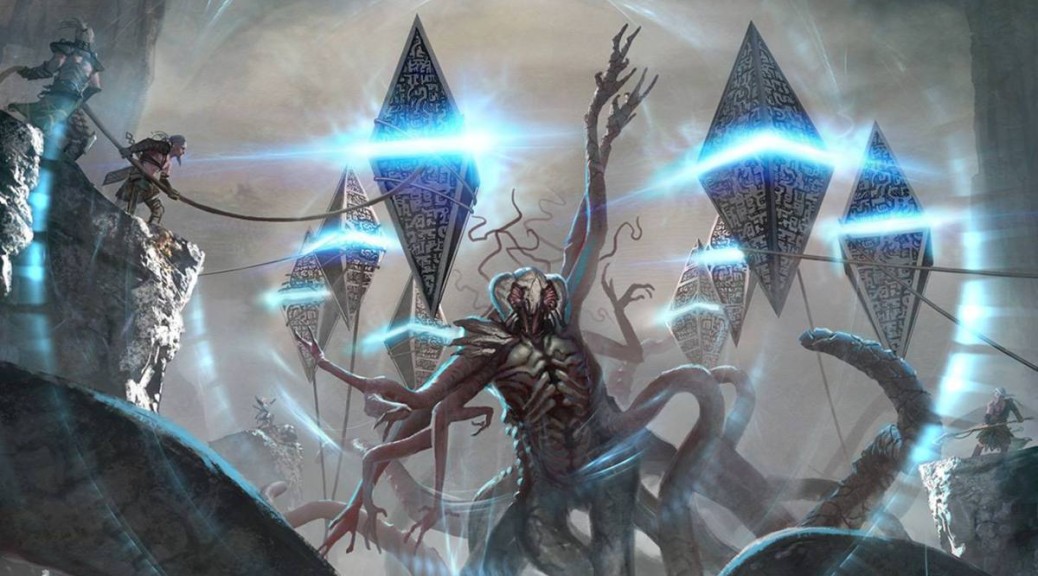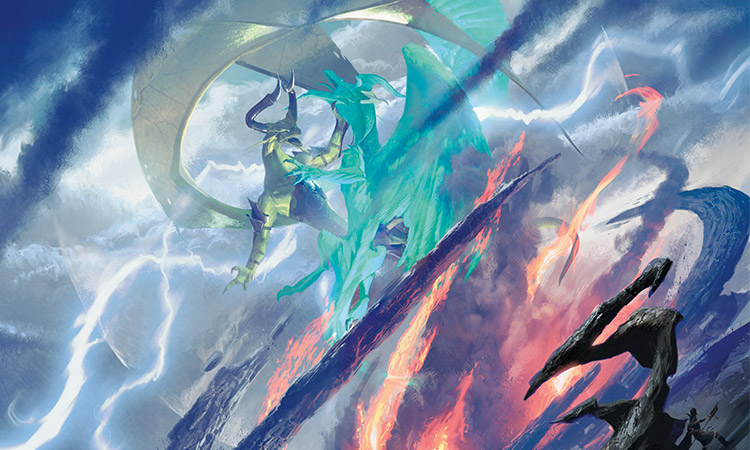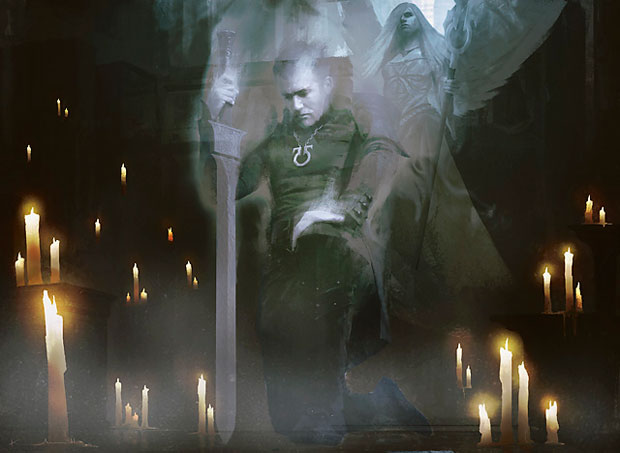By: Travis Allen
@wizardbumpin
Don’t miss this week’s installment of MTG Fast Finance! An on-topic, no-nonsense tour through the week’s most important Magic economy changes.
Despite Standard being the overwhelmingly popular format for most players, I can’t tear myself away from Modern. Even though this past weekend’s SCG Modern Classic had perhaps the most boring top 16 we’ve seen in months, the format feels electric. With Twin banned there’s this whole new world open to players. No longer do you need to be concerned about dying if you tap out on turn 3. All over my timeline and in my Facebook chats, people are discussing new brews and bringing back old ones that couldn’t quite cut the mustard in the past. Are all of them suddenly good? Of course not. Are any of them? Also probably not. It’s still fun to try though!
I’m currently amused by the Descendants’ Path Eldrazi deck, and not just because I’ve got a stack of Paths.
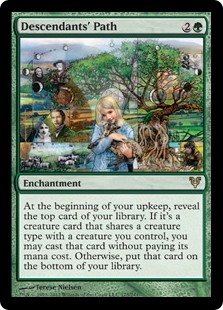
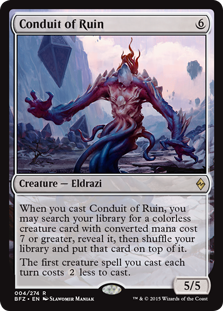

This is the basic formula. Descendant’s Path on turn 3, Conduit of Ruin (thanks to Eye of Ugin and Eldrazi Temple) on turn 4, and cast Emrakul, the Aeons Torn for free turn 5. Or really, any Eldrazi on turn 4, and just hope to hit blind every turn after that. Mutavault gives us free shots at Path triggers when we don’t have a board presence, and if we’re already in green, Ancient Stirrings is phenomenal when all your creatures, all of your lands, and some of your spells are colorless. I doubt this is particularly better than the other Eldrazi builds, but it sure is fun looking. It’s mostly just refreshing that you can play three-mana enchantments without worrying that you’re going to die to an empty board.
Removing Twin from the format unsurprisingly was not unanimously hailed as a wise idea. Corbin Hosler wrote an excellent piece here on MTGPrice about the topic, Sam Black contributed his typical outstanding insight, and PVDDR didn’t shy away from chiming in either. While I’m personally pleased with the change, if only for change’s sake, there was a larger thread entangled in the week-long discussion, one which isn’t new, and isn’t over yet.
The Problem
If you’ve been playing Magic for a few years now, you may remember that Wizards at one point axed the Block and Modern Pro Tours. All Pro Tours were to become Standard only. While there weren’t many tears shed over the loss of Block (although for our niche community it was a big loss), people were real angry Modern was being taken away. A format’s presence on the largest stage the game has to offer, and an official stage at that, grants true validity. It says “yes, Wizards of the Coast believes in, agrees with, and supports this way to play Magic as a true format.” Without Modern at the Pro Tour, players were scared of many things — scared WotC would drop support for the format, scared it would dry up locally, scared of stagnation. Most of all, I think they were scared of a loss of legitimacy. I certainly felt that way.
Wizards capitulated, and gave us back the Modern Pro Tour as the first to be played each year. Winter sets hadn’t been affecting Modern much the last few years, and so it was the easiest Standard Pro Tour to toss under the bus. Players rejoiced; their favorite format (well for some of us) had remained legitimate.
Keeping the Modern Pro Tour was not without a cost, though, and it’s a cost Wizards, pros, and average players have each paid.
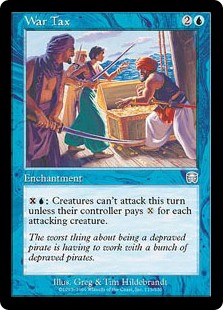
From Wizard’s perspective, it’s essentially lost revenue. Pro Tours are a marketing tool, and are designed to highlight the new set. The problem is that Modern frequently fails to highlight the latest set. While Oath of the Gatewatch may prove an exception — I’m looking at you, Thought-Knot Seer — for the most part, the latest set doesn’t do much to Modern as a whole. Spending all that money and energy on a Pro Tour that isn’t accomplishing what they want it to in the first place isn’t ideal. Remember that we as players see the Pro Tour as our own Superbowl, our own Olympics, our own Wimbeldon. It’s about the game. And while Aaron Forsythe and Erik Lauer likely share our feelings to some degree, the executive suite at Hasbro doesn’t give a rat’s ass about running the Pro Tour out of respect for the game. If the Pro Tour isn’t profitable, they’ll stop doing it.
From a pro’s perspective, or at least some of them, Modern isn’t a fun Pro Tour format. Standard tends to change fairly dramatically with each new set; especially so with the new two-set block structure. Modern, however, sees far less changes made with broad strokes. Affinity has shown up at every Pro Tour, and you can be damn sure it’s going to show up at this one too. There’s also the characteristic that the format leans heavily on sideboards in general. While I don’t agree with everything he says, PVDDR was perceptive with his discussion about that particular facet here. The tl;dr is that Modern is a single fair deck (Jund or Abzan) and a mountain of unfair decks (Tron, Scapeshift, Storm, Infect, Bogles…literally everything else).
From a typical player’s perspective, there isn’t a problem. That, however, doesn’t mean there isn’t actually a problem. It means that it’s difficult at times for us to see, but not that it doesn’t exist. It’s only now, after the Twin ban, that it’s been discussed with such clarity and begrudging acceptance.
You see, the existence of a Modern Pro Tour shapes the way Wizards manages the format. Summer Bloom’s ban is a perfect example of this. It became clear that deck was bad for the format nearly a year ago at Pro Tour Fate Reforged. Bloom’s raw power and blinding speed was on display time and time again in the following months, clearly violating the “turn four” rule explicitly stated by Wizards. In all honesty, it should have been banned if not at the Dragons of Tarkir B&R update, then at least the Magic Origins or Battle for Zendikar updates. Instead, the ban was held for Oath of the Gatewatch, just a few weeks before the subsequent Modern Pro Tour, one year after the deck’s rise to power. Why was it held? So as to create the most exciting and interesting PT possible. Banning Summer Bloom when Magic Origins was released would mean that in the subsequent months, the post-Bloom format would have been figured out. People preparing for the PT would know exactly what the format looked like at that point in time. Instead though, Bloom was banned just two weeks before the Pro Tour, which means the updated Modern format will be on display for the first time this coming weekend.
Splinter Twin’s ban is the same story. By holding off on the Twin ban until right before the Pro Tour, players are excited to see a brand new Modern format being attacked at the highest level, rather than having already watched the change play out over several months on the SCG and GP circuit. Without a Modern Pro Tour, these changes may have been made when they were appropriate — Summer Bloom in the summer, and Twin in the fall. Instead, they were delayed so as to create the most compelling Pro Tour possible. The existence of a Modern Pro Tour didn’t change the content of the bans — Wizards was going to ban those cards with or without a Modern PT — but it changed the timing.
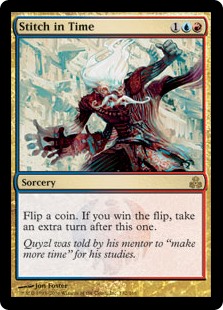
That’s what makes people uncomfortable. It feels as if the format is managed not for the health of it, as we see with Legacy changes happening as needed, but rather as if it’s managed to maximize viewership for the Pro Tour. And make no mistake about it, it is. A Modern Pro Tour means that we only get to see updates to the format once a year, rather than sprinkled around where appropriate. With Twin’s departure it’s possible Ancestral Vision can be unbanned, but rather than attempt it in six months, where it may otherwise be appropriate, Wizards will sit on their decision until February 2017. With only one change to the B&R list a year, players are forced to suffer through decks that are too good, but not at “emergency ban” level for much longer than they would otherwise.
Solutions
Pros don’t like the Modern Pro Tour.. Players don’t (or shouldn’t) like it. Wizards doesn’t like it.
So what are we to do?
As someone who loves Modern over all other formats, the first half of the answer is clear — ditch the Modern Pro Tour. Don’t get me wrong, I was right there on Twitter yelling at Helene when they cancelled it in the first place. Now, some years later, we can all look back and agree that overall it’s not the best thing for Modern right now.
Yet, I still desperately want there to be grand stage for Modern. Grand Prixs simply don’t cut it. Players, especially pros, aren’t sufficiently incentivized to dig deep into a format that’s only played at GPs. If Modern is only ever a GP format, pros will play either what they played last time or they’ll check out the top few builds on mtgtop8, and that will be it. Meanwhile, players won’t feel like there’s a true “gold standard” for Modern, and without a Modern Pro Tour, the format simply won’t feel as legitimate as Standard.
We all seem to have accepted without discussion an idea of mutual exclusivity; that either there’s a Modern Pro Tour and all the trappings that come with it, or we’re resigned to only ever play and watch Modern at Grand Prixs. It’s one or the other, and all of the conversations I see and participate in are predicated on this premise. One thing I haven’t seen mentioned really at all is the idea of a new, professional-level Modern event.
What if we can have our cake and eat it too? Let’s move all the current Pro Tours to Standard and let those be what they are. Then, let’s make a whole new event that’s all about Modern. It doesn’t need to be a “Pro Tour” per se, but it needs to feel like it’s at the same level. The prize payout needs to be reason enough for pros to spend a week or two working on coming up with great decks, rather than showing up with what worked last time. It could be the Modern Championships or something like that. Have it once a year, syncing up with the release of the Modern Masters series.
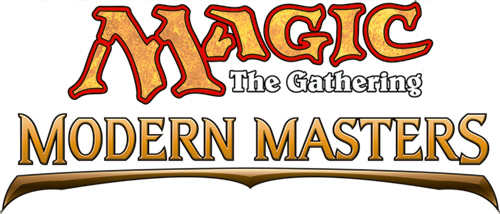
Spinning Modern off from the Pro Tour would open a lot of design space for the event, because it wouldn’t need to adhere to the typical PT structure. Rather than use the same invite system, what if instead it took the top 64 players from each of the past four Pro Tours, plus the top 16 of each Modern GP? I didn’t run the math to see how many players that is, but the numbers could be extended down as necessary. Hell, toss in the SCG Modern Opens too. If you’ve performed well at a major Modern event in the last year, you get to go to the Modern Championships. Now you’re getting not only generically good Magic players like Paul Rietzl, you’re getting players that love to dig deep into the Modern format specifically.
Furthermore, what if we adjust the tournament structure? Instead of the modified Swiss we see in most cases, what about a different arrangement that changes some equations? We could have a shorter Swiss with best of five games rather than three. Or expand sideboards to 20 cards rather than 15. Or whatever works best. I’m sure people more familiar with tournament structure and its intersection with gameplay could craft some creative and exciting ways to host an event tailor made for Modern. I don’t know what the right configuration looks like, but with free reign to design a tournament that encourages innovation and experimentation, we could have a thrilling, engaging Modern event.
With Modern standing on its own legs, in its own professional-level event, management of the B&R list can change as well. Wizards could stop holding changes until the yearly event, and instead dole them out as necessary. This would be especially true if the Modern Championships wasn’t just a yearly event, but instead twice a year.
That leads me to an even grander idea. What if there were two Pro Tours? There would of course be the Standard Pro Tour, which is what we’ve got right now. Then running alongside it we’d also have the Modern Pro Tour. A Modern Pro Tour series would run on its own schedule, with its own PTQ system. Players would have a brand new path to success and achievement, while also an entirely different tournament series to follow and contribute to. This would stand Modern up as a fully legitimate format, on par with Standard. Even if you only ran two Modern Pro Tours a year compared to the four of Standard, it would be awesome to treat the format as its own tournament series, with its own set of rules and characteristics. Is this a pipe dream? Yeah, probably. Still fun to think about though.
Conclusions
As it stands, the Modern Pro Tour is an interloper; an infringement on what is clearly a series of Standard tournaments. It is in the best interest of Wizards, of pros, and of players to remove Modern from the Pro Tour circuit as we know it today. This doesn’t mean that it’s best to just let the format settle for SCG Opens and Grand Prixs, though. Spinning the Modern Pro Tour into a full fledged, stand-alone event would give the format room to come into its own, and allow Wizards to manage the banned and restricted list with the health of the format in mind.
Removing the Modern Pro Tour doesn’t need to be the end of the format. It can be the beginning.
